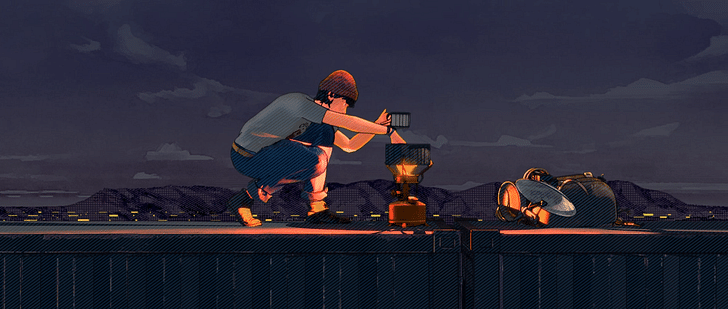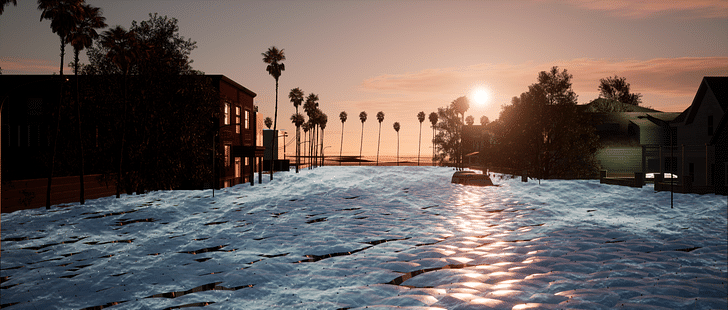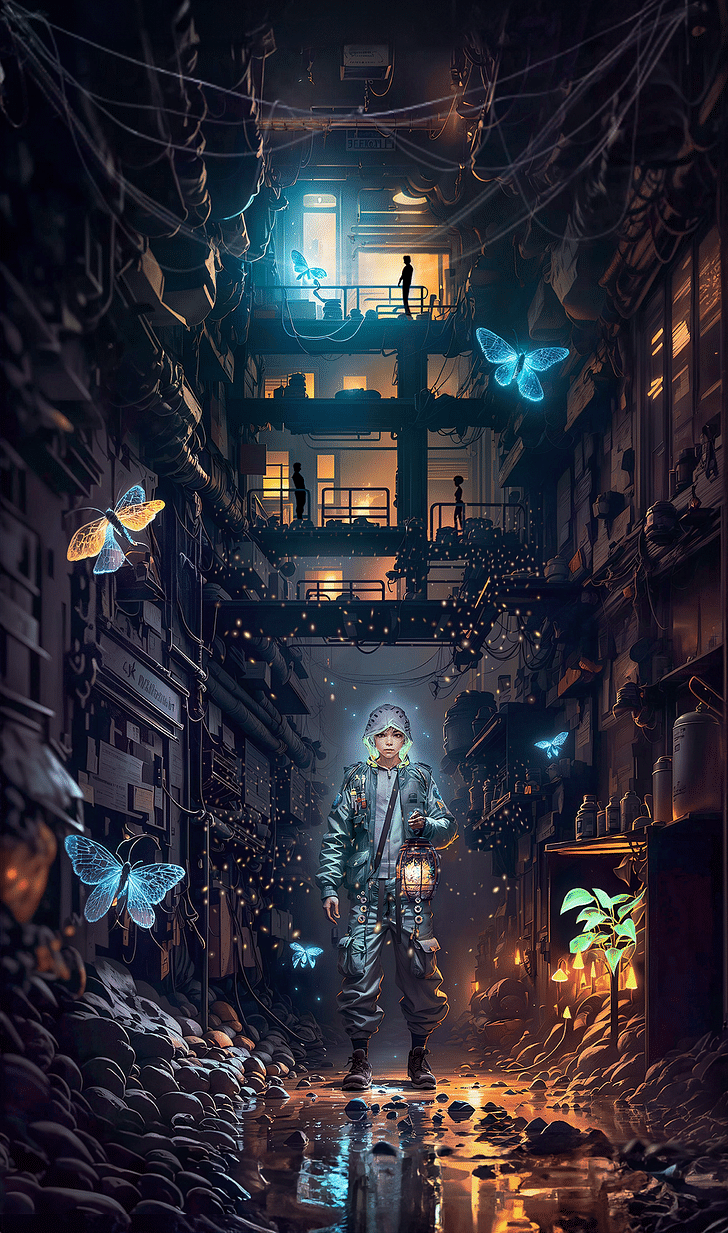

Archinect last spoke with Natasha Sandmeier on the themes of visual media and narrative storytelling in 2019. Back then, few could have imagined the seismic impact that generative AI would have on such fields. In her leading role at UCLA AUD's Entertainment Studio, Sandmeier sits at the forefront of an architectural academic landscape, already asking what the recent popularized adoption of AI in design and world-building means for authorship, ethics, representation, learning criteria, and the role of the architect.
The intervening four years since 2019 have also seen a shift in Sandmeier's own responsibilities. Beyond her position as an assistant adjunct professor at UCLA, Sandmeier is now the Executive Director of Los Angeles' A+D Museum, offering yet another outlet to explore the question of how technology is changing the face of architecture and media. The latest appointment adds to Sandmeier's long list of prior positions in the worlds of architectural academia, practice, and culture, including as a project architect for OMA in Rotterdam and a lecturer at the Architectural Association in London.
In July 2023, Archinect’s Niall Patrick Walsh spoke with Sandmeier about her work across academia and practice, including reflections on how artificial intelligence is changing the landscape of architectural education, narrative storytelling, and world-building. The discussion, edited slightly for clarity, is published below.
This article is part of the Archinect In-Depth: Artificial Intelligence series.
Niall Patrick Walsh: Archinect last spoke with you in 2019, but for newer readers, could you give an introduction to your roles across design and education?
Natasha Sandmeier: I am an architect and educator based in Los Angeles, where I lead the postgraduate Entertainment Studio at UCLA AUD. At the Entertainment Studio, we work predominantly in the visualization space, thinking about ways to build stories centering on the built environment, how we live in the world, and how it might transform in the imminent near future of the next quarter century. Our speculations intentionally stay in the near present or near future, so that we don’t stray too far into the fanciful or unattainable. For example, 25 years ago from now was 1998, and although the world was quite different then, it wasn’t alien to where we are today.
Beyond the Entertainment Studio, I recently became the Executive Director of the A+D Museum here in Los Angeles, where we are working to advance the next generation of museum programming and community building. During the pandemic, the museum transitioned to a virtual programming format, so our most present mission is guiding our re-entry into the physical museum world, which we have been doing over the past few months.
Package Pachinko PPX Event Launch by Takin Daneshmir, Willie Wu, Luying Xu (UCLA AUD Entertainment Studio 2022), Package Pachinko PPX, is a tongue-in-cheek worldbuild (website, product shop, package app, dating app, YouTube cosplay, and testimonials, and more) conceived in response to the 2021 Long Beach logistics crisis. PPX is an AI-supported sharing economy built to gamify package delivery from the Port of Long Beach throughout LA County.
How did these interests in representation and narratives emerge to become central to your career? Do they trace back to your own education, or did they emerge later throughout your architectural trajectory?
My interest in representation stems back to my time as an architect at OMA in The Netherlands. We were producing (even for the 1990’s) often incredibly fast and crude collages that allowed us to explore, and to communicate, vital qualities of the spaces we were designing, along with how to inhabit them. I came to understand how important the image was as a medium for communication. By the time I moved to London to work and teach at the Architectural Association, the idea of the image was a central component of world-building and spatial storytelling, and as a dominant form of communication.

Looking back at your reflectionsin 2019, there is much that can be applied to the landscape of 2023, particularly with the popularization of generative AI with text-to-image tools. Back then, you noted that:
“For better or for worse, we are entering an age where images and media representations of people, cities, and territories are often more powerful in defining what they are than the people, cities, and territories themselves. We live in a world where the line between fiction and reality is becoming less of a line and more of a gradated zone. Image-making technologies — from Generative Adversarial Networks (GANs) to real-time raytracing game engines — are making photorealistic synthetic imagery available to anybody with a decent laptop and some time to spare on YouTube tutorials.”
You went on to reflect on the “agency and responsibility of the designer, architect, and world builder” in this new world. With these latest advances in generative AI, have you seen any interesting changes or shifts in the landscape of visualization and media in your work and/or your students’ work?
In the present context, the question of ‘what does it mean to be an architect’ is still there, but it has accelerated and intensified. I wouldn’t say the role of the architect has changed, per se. It is in the same place it has always been: The architect is a world builder. That aspect of the role is safe, in my view.
Thinking about my students today, and indeed thinking back on my own time as a student, I do not believe there are many creatives who aspire to draw door details for three months or to endlessly clean up red-line drawings. Yet, these constitute the majority of tasks for many architects. This was never the dream of becoming an architect. Most architecture students are dreamers and world changers at heart. You enter architecture school with big ideas about improving the world and asking how you can effect change through the design of the built environment, houses, streets, cities, etc. That dream hasn’t changed.
Most architecture students are dreamers and world changers at heart.—Natasha Sandmeier

What new technologies such as ChatGPT have instead demonstrated is our willingness to outsource menial or repetitive labor. If we can outsource such taxing labor, whether door details or miscellaneous writing, AI has the potential to impact our workflow positively while also opening new doors and avenues of exploration for the profession.
Recently, I was studying the roles and responsibilities of architects in designing cities and suburbs, including Ellen Dunham-Jones’ observation that architects design only a small percentage of suburban development. Massive developments are largely developer-led with in-house designers and architecture teams. If we as a profession can offer more affordable services by outsourcing repetitive work, there is hope that we can capture some of the growth opportunities in areas currently dominated by developers.
In our studio, we seek to find ways to build images that represent world-building and to find ways of growing the audience of the architectural profession.—Natasha Sandmeier
There’s certainly a degree of fear-mongering at the moment surrounding AI and architectural labor, as there was 20 years ago when many were worried about the risk of scripts and parametric design erasing architectural jobs. Of course, we are not isolated in this particular moment, with many professions and labor groups concerned about the impact of AI. However, I see a potential for the technology to productively effect change in the profession.
That’s quite an optimistic outlook, but that is an outlook we try and push in our studio. Dystopia is much easier to render than optimism. Within the role of world-building, consulting, and being the interface between a client and space, I believe architects are safe. In our studio, we seek to find ways to build images that represent world-building and to find ways of growing the audience of the architectural profession. Technological advancements continue to make this mission more accessible for us. We can invest less time in learning software, and more time conceptualizing and developing a clear identity.
I had conversations recently with Behnaz Farahi and Amanda Talbot, who both spoke to this idea of accessibility and AI tools leveling the playing field across the architectural profession when it comes to representation and visualization. Behnaz spoke about it through a geographical lens, noting how a designer in Iran now had access to the same powerful tool as a designer in California in a way that more expensive software such as Adobe might not facilitate. Amanda spoke about it from a skills standpoint and noted that in her office, those who traditionally didn't have strong visualization or representational skills have now become empowered. They both speak to your point on how technological advancements can improve accessibility in this field.
Absolutely. I even have a teenage son who has spent hours on Midjourney generating images of spaces, buildings, and environments, even though he has no plans to enter architecture. Speaking of that democratizing element, it undoubtedly allows us to visualize highly complex concepts with unbelievable ease. However, coming from the standpoint of an educator trying to guide a future architect into their career, I would warn that the ease of creating infinite images using generative AI tools enters an awkward space when it comes up against the idea of style. Students can become too enamored with the detail and precision through which Midjourney can create imagery, which leads me to ask them: "Is this your style? Is this in your hand?"
When a student presents me with an image from Midjourney, is this now a new style they are adopting simply by virtue of the fact that this is what the tool generated for them?—Natasha Sandmeier
If I type a couple of random prompts, I can generate a whole range of imagery on any subject I wish, which leads to an interesting relationship between what I want and what I get, and if what I get is close enough to what I want or not, regardless of whether the image is visually attractive or not. Where does the agency of the designer come into play? How do you make critical decisions about the outputs? When a student presents me with an image from Midjourney, is this now a new style they are adopting simply by virtue of the fact that this is what the tool generated for them? Who becomes the author? How do you judge or assess authorship? Conversely, does that even matter anymore? Is this an antiquated question from someone who was educated before the age of AI? I’m also open to acknowledging that.

You are one of many educators who will have to grapple with these questions throughout this new academic year. Do you have any advice, direction, or reflections from your own experience that might be relevant to your academic peers?
It’s been an interesting moment for me to interrogate my own expectations or desires. Whenever these major technological shifts occur, we as educators always have to re-examine what we are assessing. What are our criteria? Are we applying criteria that were relevant in a prior age that has passed? If so, it is vital for us to develop a new set of criteria, which may even involve collaborating with students. The issue of control is interesting to me, but it could also be an old, nostalgic idea. I’m less interested in trying to find the meaning in a piece of work that is generated with AI but in understanding the work’s ambition, relevance, how it leads on to the next stage, and if that is a deliberate trajectory. The question of whether work is being led by AI or by the human individual is something that we should perhaps experiment with.
Are we applying criteria that were relevant in a prior age that has passed?—Natasha Sandmeier

This goes to another point you made in your 2019 interview, where you said that “part of architectural academia’s responsibility is to keep up with social and cultural consequences of our technological innovations.” I have had many conversations on the topic of bias in artificial intelligence and the risks of AI systems propagating stereotypes. It seems that this is another key cultural consequence of AI that students will have to confront.
This is true, and it was an issue even before AI. Sometimes, students will populate their films and videos with free downloads of stock characters, all of which will be white males. As educators, we then have a conversation with the students in which we say: “I know this was the easiest figure to find, and the others require payment, but really, who is your main character? Who is the protagonist?” Addressing bias in these media and technologies is critical. The social and cultural impact of imagery has always been something that resonated with the Entertainment Studio and is something I also engaged with before I came to UCLA.
One story that stays in my mind comes from a project I undertook with students at the Architectural Association in London in 2011–2012. We were creating a library of searchable images where students would find historical imagery from different decades and insert themselves into them. We were exploring the idea of a ‘pre-history’ or a ‘fictional present’ in which students in 2011 were inserted into images from 1943. Years later, a guest lecturer came to the AA to deliver a talk, and he showed a photograph of Le Corbusier visiting the AA decades earlier. However, he used an image that we had put online, that still had a student from 2011 in it. This is when I became truly aware that the way in which we search for material online is deeply flawed. It’s incredibly easy to manipulate imagery. The line between what is truth and what is fiction is becoming incredibly blurred.
In the future, reliable information could be like clean water: A defining resource scarcity that we are going to have to confront and navigate.—Natasha Sandmeier
As students start to work with material today in an era where we can shift truth so easily, we have become much more deliberate in our understanding of how we guide students in creating fictionalized worlds, always conscious of the fact that it could impact the way in which someone else might search for truth or information at a later date. More generally, the issue of just finding authentic, reliable information is becoming unbelievably difficult. Everybody is creating their own fictional worlds, and although this is an exciting exercise in the context of architectural world-building, large political and corporate entities are doing the same thing on a global scale. In the future, reliable information could be like clean water: A defining resource scarcity that we are going to have to confront and navigate. It is an interesting time to be associated with the creation of content and imagery using technology, but it must be done with care and thoughtfulness.

We’ve talked about how generative AI image tools have been used to represent the worlds imagined by your students, but I’m interested to hear your thoughts on the potential for such tools to impact the design of those worlds themselves. To take a historical analogy, when steel frames were introduced to architecture in the late 1800s, it didn’t just change the method in which a building was constructed, it literally changed what we built. Similarly, the elevator as a technology wasn’t just used as an alternative way of moving within the type of buildings that already existed but gave rise to a whole new type of building: the skyscraper.
Do you see any similar potential for generative AI to change the worlds that students imagine, or might it be confined only to representing worlds students are already conceiving of, just using a new methodology?
I am very much interested in seeing how this new cohort of students throughout the 2023–2024 academic year dives into conceptualizing their projects. At the beginning of the 2022–2023 academic year, we were working with earlier versions of Midjourney, which were nothing like what we have now with Midjourney V. Back then, the images were quite ethereal, blurry, cloudy, and frankly ugly once you overcame the initial seduction. In the Fall 2022 semester, the concept art was not developed enough as a result, but by the Spring 2023 semester, as students were completing their projects, they were beginning to build an image library using the more advanced versions of Midjourney and DALL-E that we have now. Those images were spectacular, partly because students were able to feed their own authored imagery into the tool as a launch pad and experiment with aesthetic styles.
The question of whether work is being led by AI or by the human individual is something that we should perhaps experiment with.—Natasha Sandmeier
I am curious to see the extent to which concept development will occur in collaboration with the tool this academic year. I am also curious to see how the work ages. The flurry of ghost-like Midjourney imagery generated in late 2022 looks vastly different to what we are able to generate today, thanks to the zillions of prompts and imagery generated within the past year. We now have more control over our outputs, which should go a long way to our being able to steer the tool. Otherwise, we run the risk of it determining the imagery, which in turn, too often determines the aesthetics, architectures, and, in the worst cases, the narratives of our world.

To conclude, I wanted to switch focus from academia and ask about the A+D Museum, of which you have recently become the Executive Director. Do you expect computation and artificial intelligence to manifest in some way across the museum’s future program?
It undoubtedly will. The question of how technology is changing the face of architecture and media is a relevant question for the museum. For example, October sees us host a conversation with Paul Debevec, the Chief Research Officer of Eyeline Studios – Powered by Netflix, which dwells on themes of computer vision, computer graphics, machine learning, and their connection to visual, virtual, and animated media.
If architects have one skill, it is agility. Now is a moment to capitalize on that agility.—Natasha Sandmeier
For us, the question of how forces such as technology can change and give opportunities to the profession is more productive than thinking about ways they can destroy the profession. In the media, it is all about the ‘death of labor.’ That is not to say jobs in society will be immune to disruption, but if architects have one skill, it is agility. Now is a moment to capitalize on that agility.
Niall Patrick Walsh is an architect and journalist, living in Belfast, Ireland. He writes feature articles for Archinect and leads the Archinect In-Depth series. He is also a licensed architect in the UK and Ireland, having previously worked at BDP, one of the largest design + ...
5 Comments
I'm afraid students will forget that Architecture is about building, however cool the images.
There are whole departments and disciplines at leading schools devoted to the study of architecture as imagery, dismissing construction as unworthy of intellectual investment. It's a totally different world built on French post-modernist philosophy ... a disease that's been infecting American faculties since the '80s.
Ironically, this was the same criticism leveled at Universities when they followed the Beaux Arts model. Fear of seduction, thanks Plato!
this drawing looks like the author actually knows something about building though
That's the ironic part. I never understood it but then again I never understood the reason for rejecting tradition in architecture anymore than one would in music, food, etc. It's a matter of taste.
Block this user
Are you sure you want to block this user and hide all related comments throughout the site?
Archinect
This is your first comment on Archinect. Your comment will be visible once approved.